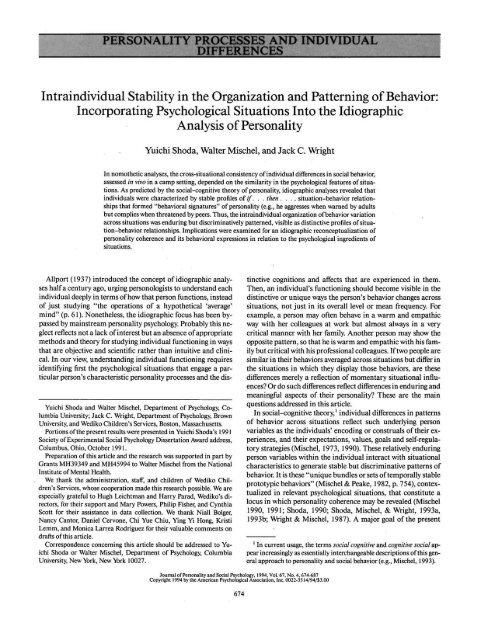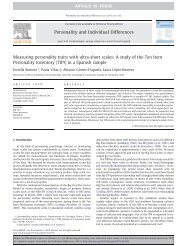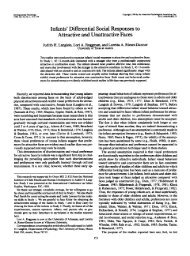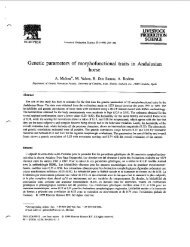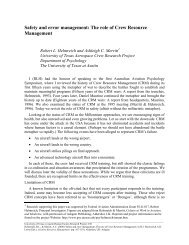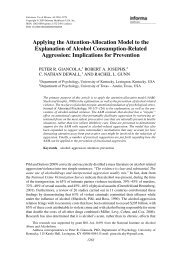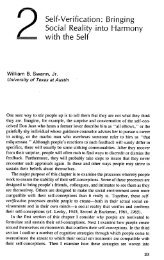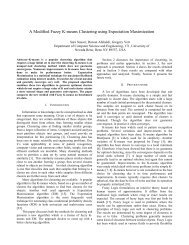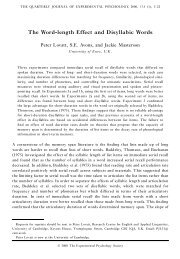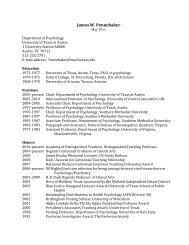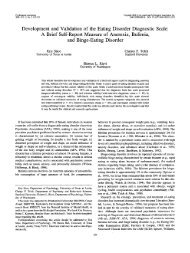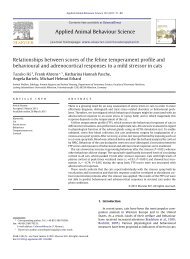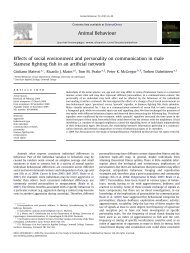PERSONALITY PROCESSES AND INDIVIDUAL DIFFERENCES ...
PERSONALITY PROCESSES AND INDIVIDUAL DIFFERENCES ...
PERSONALITY PROCESSES AND INDIVIDUAL DIFFERENCES ...
You also want an ePaper? Increase the reach of your titles
YUMPU automatically turns print PDFs into web optimized ePapers that Google loves.
<strong>PERSONALITY</strong> <strong>PROCESSES</strong> <strong>AND</strong> <strong>INDIVIDUAL</strong><br />
<strong>DIFFERENCES</strong><br />
Intraindividual Stability in the Organization and Patterning of Behavior:<br />
Incorporating Psychological Situations Into the Idiographic<br />
Analysis of Personality<br />
Yuichi Shoda, Walter Mischel, and Jack C. Wright<br />
In nomothetic analyses, the cross-situational consistency of individual differences in social behavior,<br />
assessed in vivo in a camp setting, depended on the similarity in the psychological features of situations.<br />
As predicted by the social-cognitive theory of personality, idiographic analyses revealed that<br />
individuals were characterized by stable profiles of;/. . . then . . . , situation-behavior relationships<br />
that formed "behavioral signatures" of personality (e.g., he aggresses when warned by adults<br />
but complies when threatened by peers. Thus, the intraindividual organization of behavior variation<br />
across situations was enduring but discriminatively patterned, visible as distinctive profiles of situation-behavior<br />
relationships. Implications were examined for an idiographic reconceptualization of<br />
personality coherence and its behavioral expressions in relation to the psychological ingredients of<br />
situations.<br />
Allport (1937) introduced the concept of idiographic analyses<br />
half a century ago, urging personologists to understand each<br />
individual deeply in terms of how that person functions, instead<br />
of just studying "the operations of a hypothetical 'average'<br />
mind" (p. 61). Nonetheless, the idiographic focus has been bypassed<br />
by mainstream personality psychology. Probably this neglect<br />
reflects not a lack of interest but an absence of appropriate<br />
methods and theory for studying individual functioning in ways<br />
that are objective and scientific rather than intuitive and clinical.<br />
In our view, understanding individual functioning requires<br />
identifying first the psychological situations that engage a particular<br />
person's characteristic personality processes and the dis-<br />
Yuichi Shoda and Walter Mischel, Department of Psychology, Columbia<br />
University; Jack C. Wright, Department of Psychology, Brown<br />
University, and Wediko Children's Services, Boston, Massachusetts.<br />
Portions of the present results were presented in Yuichi Shoda's 1991<br />
Society of Experimental Social Psychology Dissertation Award address,<br />
Columbus, Ohio, October 1991.<br />
Preparation of this article and the research was supported in part by<br />
Grants MH39349 and MH45994 to Walter Mischel from the National<br />
Institute of Mental Health.<br />
We thank the administration, staff, and children of Wediko Children's<br />
Services, whose cooperation made this research possible. We are<br />
especially grateful to Hugh Leichtman and Harry Parad, Wediko's directors,<br />
for their support and Mary Powers, Philip Fisher, and Cynthia<br />
Scott for their assistance in data collection. We thank Niall Bolger,<br />
Nancy Cantor, Daniel Cervone, Chi Yue Chiu, Ying Yi Hong, Kristi<br />
Lemm, and Monica Larrea Rodriguez for their valuable comments on<br />
drafts of this article.<br />
Correspondence concerning this article should be addressed to Yuichi<br />
Shoda or Walter Mischel, Department of Psychology, Columbia<br />
University, New York, New York 10027.<br />
Journal of Personality and Social Psychology, 1994, Vol. 67, No. 4, 674-687<br />
Copyright 1994 by the American Psychological Association, Inc. OO22-3514/94/S3.0O<br />
674<br />
tinctive cognitions and affects that are experienced in them.<br />
Then, an individual's functioning should become visible in the<br />
distinctive or unique ways the person's behavior changes across<br />
situations, not just in its overall level or mean frequency. For<br />
example, a person may often behave in a warm and empathic<br />
way with her colleagues at work but almost always in a very<br />
critical manner with her family. Another person may show the<br />
opposite pattern, so that he is warm and empathic with his family<br />
but critical with his professional colleagues. If two people are<br />
similar in their behaviors averaged across situations but differ in<br />
the situations in which they display those behaviors, are these<br />
differences merely a reflection of momentary situational influences?<br />
Or do such differences reflect differences in enduring and<br />
meaningful aspects of their personality? These are the main<br />
questions addressed in this article.<br />
In social-cognitive theory, 1 individual differences in patterns<br />
of behavior across situations reflect such underlying person<br />
variables as the individuals' encoding or construals of their experiences,<br />
and their expectations, values, goals and self-regulatory<br />
strategies (Mischel, 1973, 1990). These relatively enduring<br />
person variables within the individual interact with situational<br />
characteristics to generate stable but discriminative patterns of<br />
behavior. It is these "unique bundles or sets of temporally stable<br />
prototypic behaviors" (Mischel & Peake, 1982, p. 754), contextualized<br />
in relevant psychological situations, that constitute a<br />
locus in which personality coherence may be revealed (Mischel<br />
1990, 1991; Shoda, 1990; Shoda, Mischel, & Wright, 1993a,<br />
1993b; Wright & Mischel, 1987). A major goal of the present<br />
1 In current usage, the terms social cognitive and cognitive social appear<br />
increasingly as essentially interchangeable descriptions of this general<br />
approach to personality and social behavior (e.g., Mischel, 1993).
esearch was to obtain empirical evidence relevant to the validity<br />
of this conception of intraindividual personality coherence.<br />
Our analysis of the organization of the individual's behavior<br />
is conditional or contextual in the sense that the fundamental<br />
unit of observation is not the unconditional probability of traitrelevant<br />
behavior (e.g., the tendency to be extraverted), but<br />
rather the conditional probability of a given type of behavior in<br />
given types of psychological conditions or situations (e.g., Patterson,<br />
1982; Patterson & Reid, 1984; Shoda, Mischel, &<br />
Wright, 1989; Wright & Mischel, 1987, 1988). The traditional<br />
use of the unconditional probability of trait-relevant behavior<br />
is appropriate and useful for many purposes, such as selecting<br />
persons on the basis of their predicted future behaviors on average<br />
in unspecified situations. However, beyond identifying individual<br />
differences in average levels of behavior, we view the intraindividual<br />
variability of behavior itself as the behavioral phenomenon<br />
of interest. These patterns of if ... then . . .<br />
relations link psychological situations to the person's relevant<br />
behaviors (e.g., Mischel, 1973).<br />
Responsive to the many calls for a shift from a variable-centered<br />
approach in personality research to one that is more person-centered<br />
(e.g., Carlson, 1971; John, 1990), our analysis is<br />
indeed person-centered and focuses on the within-person (intraindividual)<br />
organization of behavior and on personality coherence.<br />
However, in the search for intraindividual stability, we<br />
do not pursue the traditional configuration of global dispositions<br />
or behavioral tendencies that characterize a person (e.g.,<br />
high in extraversion and low in conscientiousness). Instead, our<br />
approach is unique in focusing on how a given type of behavior<br />
(e.g., aggression) by an individual varies distinctively but predictably<br />
across different types of psychological situations (e.g.,<br />
ifAheX,butifBheY).<br />
Stability in these patterns of if. . . then . . ., situation-behavior<br />
relations is predicted to the degree that there is stability<br />
in the underlying person variables, such as the individual's ways<br />
of construing the situation and his or her relevant goals, values,<br />
expectancies, and the like, as they are activated in the particular<br />
situation (Mischel, 1973, 1990). Suppose for example that one<br />
person encodes events like being teased or provoked by his peer<br />
as an offense that requires a response in kind, whereas he sees<br />
being warned by his supervisor as a situation in which he has<br />
to comply to avoid negative consequences. For another person,<br />
however, being teased or provoked by a peer is encoded as normal<br />
and acceptable bids for interaction, whereas warning by a<br />
supervisor is construed as a personal violation by an unaccepted<br />
authority. Such differences in the subjective meaning of different<br />
situations, reflecting stable differences in encoding (e.g.,<br />
Dodge, 1986), may result in activation of different expectancies,<br />
goals, values, and other person variables. Behaviorally, the<br />
effects should be visible as distinctively patterned if. . . then<br />
. . . , situation-behavior configurations, expressed as stable<br />
profiles of behavior variability across situations that differ in<br />
their psychological meaning for the individual. In the present<br />
article, we examine empirical data on the stability of such intraindividual<br />
situation-behavior configurations to test this<br />
hypothesis.<br />
Direct evidence that such patterns of variability in behavior<br />
are stable and distinctive within individuals would allow one<br />
STABILITY OF INTRA<strong>INDIVIDUAL</strong> BEHAVIOR PATTERNING 675<br />
to conceptualize them as behavioral signatures of personality,<br />
rather than as measurement error or as data contradictory to<br />
personality coherence. This calls for an idiographic analysis of<br />
behavioral coherence, using an extensive observation system to<br />
assess people's behaviors in natural social interactions over<br />
many occasions. Unlike many earlier studies of person-situation<br />
links that relied exclusively on self-reports, we required behavioral<br />
data that would allow us to examine individual differences<br />
in people's distinctive patterns of relating to these naturally<br />
occurring social situations. In our long-term research<br />
program, these patterns were obtained by systematic behavior<br />
observations in vivo over the course of a summer in a children's<br />
residential camp setting, Wediko Children's Services' summer<br />
program in Hillsboro, New Hampshire. The results yielded an<br />
extensive archival database that allows systematic analyses to<br />
identify personality coherence in behavior as it unfolds across<br />
naturalistic situations and over many occasions (e.g., Shoda,<br />
1990; Shoda etal., 1989,1993a, 1993b).<br />
Within a given ecological setting, such as the Wediko camp,<br />
situations may be conceptualized at different levels and with<br />
alternative units (Mischel, 1991; Shoda, 1990; Shoda et al.,<br />
1993b). At one level are the nominal situations that have been<br />
operationalized in studies of behavioral consistency traditionally<br />
(e.g., Hartshorne& May, 1928;Newcomb, 1929; Mischel &<br />
Peake, 1982). Typically they were dictated by the structure of<br />
the particular ecology (the setting), rather than by their potential<br />
psychological impact on, and meaning for, the person or by<br />
the generalizability of the observations obtained within them.<br />
Usually these nominal situations are highly complex and contain<br />
a wide array of different psychological features (Shoda et<br />
al., 1993a). In a summer camp, such as Newcomb's (1929)<br />
Camp Wawokiye or the present site, Wediko, woodworking, for<br />
example, may be a nominal situation that contains such diverse<br />
interpersonal psychological events as being praised, frustrated,<br />
teased, and punished. Nominal situations such as woodworking<br />
in the camp also tend to limit generalizability to other life settings.<br />
Thus, individual differences in relation to a specific nominal<br />
situation, even if highly stable, necessarily would be of<br />
modest psychological interest beyond the setting. On the other<br />
hand, at a deeper level, situations may be defined to capture<br />
basic psychological features or ingredients that occur in many<br />
different nominal situations and settings. In that case, information<br />
about an individual's behavior tendencies in relation to<br />
them is potentially generalizable to other situations that also<br />
contain these features. The utility of analyzing behaviors in<br />
terms of their stable relations to particular psychological features,<br />
hinges mostly on how widely the features occur in diverse<br />
nominal situations and different ecological settings.<br />
Table 1 summarizes and illustrates the distinctions among<br />
ecological settings, nominal situations, psychological features,<br />
and the interpersonal situations used as units of situations in the<br />
present study. As the table indicates, such events as being teased,<br />
provoked, or threatened are embedded within different nominal<br />
situations and contain the salient psychological features that<br />
are encoded by individuals and that affect their behaviors dynamically<br />
in the stream of social interactions. Just as individuals'<br />
responses to particular medications can be understood<br />
more fundamentally by considering the specific active ingredi-
676 Y. SHODA, W. MISCHEL, <strong>AND</strong> J. WRIGHT<br />
Table 1<br />
Examples of Ecological Settings, Nominal Situations, Interpersonal Situations,<br />
and Psychological Features<br />
Setting<br />
Nominal<br />
situations Interpersonal situations<br />
Psychological<br />
features<br />
Camp Woodworking When peer initiated positive contact peer, positive<br />
When peer teased, provoked, or threatened peer, negative<br />
When praised by an adult adult, positive<br />
When warned by an adult adult, negative<br />
When punished by an adult adult, negative<br />
Cabin meeting When peer initiated positive contact peer, positive<br />
When peer teased, provoked, or threatened peer, negative<br />
When praised by an adult adult, positive<br />
When warned by an adult adult, negative<br />
When punished by an adult adult, negative<br />
School Playground When peer initiated positive contact peer, positive<br />
When peer teased, provoked, or threatened peer, negative<br />
When praised by an adult adult, positive<br />
When warned by an adult adult, negative<br />
When punished by an adult adult, negative<br />
Classroom When peer initiated positive contact peer, positive<br />
When peer teased, provoked, or threatened peer, negative<br />
When praised by an adult adult, positive<br />
When warned by an adult adult, negative<br />
When punished by an adult adult, negative<br />
Home Mealtime When peer initiated positive contact peer, positive<br />
When peer teased, provoked, or threatened peer, negative<br />
When praised by an adult adult, positive<br />
When warned by an adult adult, negative<br />
When punished by an adult adult, negative<br />
ents rather than the brand names, the social-cognitive analysis<br />
of situations focuses on the psychologically active features of<br />
situations. Whereas nominal situations (such as woodworking)<br />
tend to contain heterogeneous sets of psychological features, in<br />
the present study we focused on interpersonal situations, each<br />
of which contains a relatively more homogeneous, distinct set<br />
of psychological features (Shoda et al., 1993b), as the units of<br />
analysis.<br />
The challenge in this type of analysis is to capture those features<br />
that are encoded distinctively by perceivers and that activate other<br />
relevant cognitive social person variables (e.g., expectancies and<br />
values) in the mediating process. Individual differences in response<br />
to nominal situations, such as the daily activities within a camp,<br />
then, may be analyzed in terms of the person's stable cognitive,<br />
affective, and behavioral responses to the encoded "active," psychological<br />
features within the nominal situations (e.g., Mischel,<br />
1973). These psychological features, in turn, may consist of combinations<br />
of even more specific features and may be analyzed in<br />
terms of their overlap and similarity.<br />
Focusing on interpersonal situations as the situation units of<br />
analysis embedded in their nominal situations within the eco-<br />
Watching TV When peer initiated positive contact peer, positive<br />
When peer teased, provoked, or threatened peer, negative<br />
When praised by an adult adult, positive<br />
When warned by an adult adult, negative<br />
When punished by an adult adult, negative<br />
logical setting of the research site, in this article we examine<br />
the consistency and stability of situation-behavior relations that<br />
characterize individuals. Guided by the social-cognitive approach<br />
to personality (e.g., Mischel, 1973, 1990; Shoda & Mischel,<br />
1993), we pursued an idiographic strategy. Specifically,<br />
we focused on the intraindividual organization of behavior in<br />
terms of the specific patterns in which that behavior varied<br />
across interpersonal situations, examining the stability of this<br />
pattern over time within each individual. We hypothesized that<br />
there would be significant intraindividual stability in the distinctive<br />
pattern by which the person's behavior varied predictably<br />
across particular types of these situations, visible as intraindividually<br />
stable "profiles" of if. . . then . . . , situationbehavior<br />
relations.<br />
Second, we examined the implications of these hypothesized<br />
intraindividually stable profiles of situation-behavior relations<br />
for the nomothetic analysis of cross-situational consistency.<br />
Namely, we hypothesized that the same underlying processes<br />
that generate stable and distinctive intraindividual profiles of<br />
behavior variation across these interpersonal situations also<br />
should generate cross-situational consistency in behavior to the
extent that the situations are similar in their psychologically active<br />
features. Then the degree of consistency in individual<br />
differences in behavior across different situations should be a<br />
function of the similarity in the psychological features that they<br />
shared. To test this hypothesis, we also examined a more traditional<br />
nomothetic aspect of behavior organization, focusing on<br />
the cross-situational consistency of individual differences examined<br />
separately for each type of behavior observed in each<br />
type of psychological situation.<br />
Method<br />
Research Program and Design<br />
The present article reports aspects of a large-scale field research program<br />
conducted at Wediko Children's Services, a summer camp residential<br />
program in New Hampshire (Shoda, 1990). The general population<br />
and setting have been described previously (e.g., Rodriguez, Mischel,<br />
& Shoda, 1989; Wright & Mischel, 1987, 1988). In the research<br />
program on which this article draws, a total of 84 children (60 boys and<br />
24 girls, mean age 10 years and 2 months) were observed for the entire<br />
duration of one summer session (6 weeks) in the camp.<br />
The exceptionally rich database that we collected in this research program<br />
yielded a unique data archive for the systematic analysis of social<br />
behavior as it unfolds over time and across settings. These data range<br />
from highly molecular (e.g., coding of videotaped social interactions in<br />
10-s units), to more molar (e.g., hourly ratings of behavior), to relatively<br />
global (e.g., dispositional judgments by counselors at the end of the summer).<br />
The data were collected by a team of 77 adult observers (a total of<br />
14 to 28 observers per child), with an average total of 167 hr of behavior<br />
observations for each child over the 6-week summer. Our design enabled<br />
studies of diverse facets of the organization and nature of the individual's<br />
distinctive and stable behavior patterns at various levels of specificity<br />
and depth. Specifically, at the level of nominal situations, we analyzed<br />
individual differences in the organization of social behavior, focusing<br />
on the role of competencies as the characteristic of the<br />
individuals and as a demand characteristic of the situations (Shoda et<br />
al., 1993a). At the level of interpersonal situations, we addressed the<br />
relationships between judgments of global dispositions and the behaviors<br />
of individuals who were good exemplars of dispositional categories<br />
(Shoda etal., 1993b).<br />
We designed the research program to include assessments of interpersonal<br />
situations with distinct sets of salient psychological features that<br />
are relevant, important, and consensually encoded by people in the population<br />
sampled. Five interpersonal situations were selected representing<br />
two of the most salient and observable psychological features identified<br />
in earlier research (Wright & Mischel, 1988), namely valence (positive<br />
vs. negative) of the interaction and type of person (adult counselor<br />
vs. child peer) involved in the interaction. The five situations selected to<br />
represent each combination of the two psychological features are summarized<br />
in the third column of Table 1.<br />
Specifically, throughout the 6-week summer, within each hour of<br />
camp activity, observers recorded the frequency with which each of<br />
these five types of situations occurred and whether the child responded<br />
with any of the five behavior categories of interest, namely, verbal aggression<br />
(teased, provoked, or threatened); physical aggression (hit,<br />
pushed, physically harmed); whined or displayed babyish behavior;<br />
complied or gave in; and talked prosocially (Shoda, 1990; Shoda et al.,<br />
1989, 1993b). In the present research we tested the hypotheses concerning<br />
the nature and stability of the intraindividual organization of social<br />
behavior in relationship to these situations from both the idiographic<br />
and nomothetic perspectives.<br />
STABILITY OF INTRA<strong>INDIVIDUAL</strong> BEHAVIOR PATTERNING<br />
Subjects<br />
677<br />
The subjects were the 84 children (60 boys and 24 girls) from the<br />
research program described above, who resided for 6 weeks in a summer<br />
camp residential setting (Wediko Children's Services) in New Hampshire.<br />
They ranged in age from 6 years 5 months to 13 years 2 months,<br />
with a mean of 10 years 2 months, and they resided in cabin groups of<br />
6-10 same-sex peers similar in age. This population is characterized<br />
by significant social adjustment problems, particularly with inadequate<br />
prosocial behavior and aggressive behavior in the home or school environment,<br />
and most of the youngsters are from low-income families in<br />
the Boston area. Data dealing with other questions and results from the<br />
same children assessed in the same setting and summer in the field study<br />
are reported in Shoda et al. (1989, 1993a, 1993b) and Rodriguez et al.<br />
(1989).<br />
Conditional Probabilities of Behaviors Within Each<br />
Interpersonal Situation<br />
The conditional probabilities of behaviors were based on the five types<br />
of behaviors described above, observed within each of the five types of<br />
interpersonal situations shown in Table 1. We use the term situationbehavior<br />
relation to refer to each of the 25 i/[or when]. . . then . . .<br />
conditional probabilities of the five behaviors in response to the five<br />
psychological situations recorded (e.g., prosocial talk when teased; prosocial<br />
talk when faced with a positive peer contact). The conditional<br />
probability of physical aggression when praised by an adult, however,<br />
was 0 for all except one child and therefore had little variation across<br />
individuals. Thus, this condition-behavior relation was excluded from<br />
further analyses.<br />
To compute conditional probability of subjects' behavioral responses<br />
in each psychological situation reliably, it was necessary that the subjects<br />
encounter each situation repeatedly. To ensure adequate reliability<br />
and resolution in the conditional probabilities in the analyses reported<br />
below, we therefore required that the subject encounter each type of<br />
situation at least a total of six times. Individuals differed in the number<br />
of times they encountered each of the five situations we observed. Specifically,<br />
the mean frequencies of encountering each type of situation<br />
were as follows (SD shown in parentheses): Peer teased, provoked, or<br />
threatened, 10.3 (6.5); Adult warned the child, 42.9 (19.5); Adult gave<br />
the child time out, 22.8 (16.0); Peer initiated positive social contact,<br />
39.8 (10.5); Adult praised the child verbally, 66.5 (14.6). We also used<br />
this subset to compute cross-situational consistency of conditional<br />
probabilities of behavioral responses so that all correlations reported in<br />
Table 3 are based on the same set of subjects regardless of the situation<br />
pairs involved.<br />
Intraindividual Situation-Behavior Profiles<br />
The if. . . then . . . pattern with which a given type of behavior<br />
displayed by an individual varied across the situations constituted an<br />
intraindividual situation-behavior profile. For example, Figure 1 shows<br />
a situation-behavior profile for verbal aggression for one individual and<br />
depicts how the person's verbal aggressiveness varied over the five interpersonal<br />
events shown along the horizontal axis. One may plot the absolute<br />
conditional probabilities of behavior across situations, but the<br />
variability of such a profile would reflect the differences among the situations<br />
in how people behave in them in general, constituting the normative<br />
level for each situation. For example, most people are more likely<br />
to display aggression when teased by peers than when praised by an<br />
adult. To plot the aspect of behavior variation that is distinctive for each<br />
person, therefore, we subtracted the normative (mean) profile observed<br />
in this sample of subjects from the individual's "raw" profiles, and the<br />
results were rescaled using as units the standard deviations of the behav-
678 Y. SHODA, W. MISCHEL, <strong>AND</strong> J. WRIGHT<br />
Child # 17 profile stability: r = 0.96 Child # 9 profile stability: r = 0.89<br />
PEER TEASE ADULT WARN<br />
PEER APPROACH ADULT PRAISE ADULT PUNISH<br />
PEER TEASE ADULT WARN<br />
PEER APPROACH ADULT PRAISE ADULT PUNISH<br />
Child # 28 profile stability: r = 0.49 Child #48 profile stability: r = 0.11<br />
PEER TEASE ADULT WARN<br />
PEER APPROACH ADULT PRAISE ADULT PUNISH<br />
PEER TEASE ADULT WARN<br />
PEER APPROACH ADULT PRAISE ADULT PUNISH<br />
Figure 1. Illustrative intraindividual profiles of verbal aggression across five types of psychological situations.<br />
The two lines indicate the profiles based on two different, nonoverlapping samples of occasions in<br />
which the child encountered each type of psychological situation, shown as Time 1 (solid) and Time 2<br />
(broken).<br />
ior within each situation. In short, the distinctive profile of behavior<br />
variability across situations was identified for each individual by the<br />
pattern of standardized deviations from the normative pattern in terms<br />
of standard scores computed in each situation. Figure 1 illustrates such<br />
a profile. In the present analyses, we assessed the stability of these situation-behavior<br />
profiles within individuals to test the hypothesis that the<br />
distinctive ways in which an individual's behavior varies across situations<br />
constitutes an enduring aspect of personality, rather than merely<br />
reflecting fluctuations due to uncontrolled, random factors.<br />
Indexing Profile Similarities to Determine Their<br />
Stability<br />
To index and statistically test the stability of the intraindividual, situation-behavior<br />
profiles, the total available observations of each type of<br />
situation were randomly divided to form two sets of observations.<br />
Within each set, for each subject, conditional probabilities of each type<br />
of behavior in each type of situation were computed. This procedure<br />
yielded for each person two intraindividual situation-behavior profiles<br />
observed on two different sets of occasions. The similarity of the<br />
"shapes" of the two profiles was then indexed by an ipsative correlation<br />
coefficient, computed within each individual separately, using the interpersonal<br />
situations as the units of analysis.<br />
For example, if a person's behavior profile for the five situations from<br />
one set of nominal situations (camp activities) was [ 1.0,0.5,-1.0, —0.5,<br />
0.0], and the one from the other was [0.5, 0.0, -1.5, -1.0, -0.5], the<br />
correlation between the two would be +1.0. Note that the correlation<br />
essentially reflects the stability of the rank order among the interpersonal<br />
situations within the same individual in how the individual's behavior<br />
in each situation deviates from the respective norm in each situation.<br />
In this example, both profiles indicate that the standardized (i.e.,<br />
relative to the situation norm) behavior probability was highest in the<br />
first situation, followed by the second, fifth, fourth, and then the third.<br />
The stability coefficient of +1.0 indicates that the intraindividual rank<br />
order of situations was preserved perfectly over time. If the profile from<br />
the second set was [-1.0, -0.5, 1.0, 0.5, 0.0], it would indicate a complete<br />
reversal of the intraindividual rank ordering of the five situations,<br />
and the profile stability correlation would be — 1.0.<br />
Computing Mean Consistency Coefficients Within<br />
Versus Across Interpersonal Situations<br />
As noted in the introduction, in addition to the idiographic analysis<br />
of intraindividual profile stability we also pursued a more nomothetic<br />
route to test the cross-situational consistency of if. . .then. . .relationships<br />
separately for each type of behavior in relation to each type of<br />
interpersonal situation. Therefore, to test the hypothesis that the degree<br />
of cross-situational consistency in individual differences in behavior<br />
should be a function of the similarity in the psychological features that
they shared, we examined traditional, nomothetic, cross-situational<br />
consistency coefficients of individual differences in each behavior, computed<br />
for each distinct pair of interpersonal situations. To ensure sufficient<br />
samples of observations for each type of interpersonal situation,<br />
observations from different camp activities were pooled. Specifically,<br />
the 14 camp activities were randomly grouped to form two sets of 7<br />
activities, and within each set, conditional probabilities of each type of<br />
behavior in each type of interpersonal situation were computed. The<br />
consistency of individual differences in these conditional probabilities<br />
was computed across the two sets. Different counselors led different activities,<br />
and behavior observations were made at the end of each activity<br />
on a computer-scored behavior tracking sheet by the counselor who led<br />
that activity. Because observations of behaviors in different activities<br />
were made by different counselors, consistency coefficients computed<br />
across them do not reflect possible links due to overlap in observers.<br />
To minimize chance associations present in any specific random<br />
grouping of the camp activities, this procedure was repeated 100 times,<br />
and the results were averaged using Fisher's r-to-z transformation. These<br />
average correlations should be more stable with a smaller standard error<br />
than is usually expected for a single correlation, because such averages<br />
are less subject to the sampling error associated with the specific random<br />
grouping of the 14 camp activities into two sets of 7. If the 100<br />
iterations had been conducted in independent samples, then one should<br />
be able to compute the expected standard error of the mean coefficient<br />
following the central limit theorem. However, the 100 iterations do not<br />
constitute independent samples, and therefore one cannot compute estimates<br />
of the standard error by simply applying the theorem, which<br />
assumes independence of sampling. Therefore, we used the bootstrapping<br />
procedure, whose method and theoretical rationale are described<br />
elsewhere in detail (Diaconis & Efron, 1983; Efron, 1981, 1985; Efron<br />
ATibshirani, 1986).<br />
Briefly, this computation-intensive, nonparametric method of estimating<br />
standard errors involves drawing random samples from the obtained<br />
data pool and computing the statistics of interest in each random<br />
sample. The bootstrapping procedure calls for sampling with replacement;<br />
that is, after a subject is drawn from the pool, the chosen subject<br />
is replaced back to the pool so that she or he can be chosen again. Therefore,<br />
even though it requires forming random samples of the same size<br />
as the size of the obtained data pool from which they are drawn, the<br />
exact composition of the random sample varies, due to the fact Liat in<br />
each random sample some subjects are represented multiple times while<br />
some others are not chosen. The distribution across the random samples<br />
of the statistic of interest computed in each sample (which in the case<br />
of the present analysis is the mean consistency coefficient) provides an<br />
estimate of the sampling distribution. Specifically, the standard errors<br />
reported in Table 2 are based on 500 such random samples. Within each<br />
sample, 10, rather than 100, random groupings of camp activities were<br />
made because of the limitation of computer resources; thus, we obtained<br />
conservative overestimates of standard errors and p values.<br />
Results<br />
Idiographic Analyses oflntraindividual Profile Stability<br />
Figure 1 presents examples of idiographic situation-behavior<br />
profiles for individuals, illustrating varying levels of profile stability<br />
for all five situations. The first profile in Figure 1 indicates<br />
that the pattern by which verbal aggression of Child 17 varied<br />
across the five situations was stable and distinctive. Specifically,<br />
this individual was more verbally aggressive than others when<br />
punished by an adult (standard score of over 2.0), but his level<br />
of aggression was lower than the average level when teased, provoked,<br />
or threatened by a peer (standard score of about 0.5);<br />
while in the other three situations his level of verbal aggression<br />
STABILITY OF INTRA<strong>INDIVIDUAL</strong> BEHAVIOR PATTERNING<br />
679<br />
was near average in each respective situation. The two lines indicate<br />
the profiles based on two different, nonoverlapping samples<br />
of occasions in which the child encountered each type of<br />
psychological situation, shown as Time 1 and Time 2. At both<br />
Time 1 and Time 2, his profile was characterized by the fact<br />
that his level of verbal aggression, relative to the level of the<br />
peers in each situation (i.e., the "norm"), was the highest when<br />
adults punished him and lowest when another child teased.<br />
Child 9, whose profile of verbal aggression is shown in the second<br />
panel of Figure 1, was most distinctively verbally aggressive<br />
when warned by adults and his overall profile indicated substantial<br />
stability. Child 28 (the third panel of Figure 1), on the other<br />
hand, was most distinctively verbally aggressive when peers approached<br />
him. The profile stability was relatively modest, however,<br />
because his profile with regard to the remaining psychological<br />
situations changed over time.<br />
The last panel of Figure 1, for Child 48, illustrates a case of<br />
low profile stability. His profile of verbal aggression was distinctive<br />
at Time 1 in that he was most verbally aggressive, relative to<br />
others, when praised by an adult, but this was no longer the case<br />
at Time 2.<br />
As these examples illustrate, children differed widely in the<br />
stability and nature of their intraindividual profiles for each<br />
type of behavior. To test the hypothesis that on the whole these<br />
patterns of behavior variation across situations constitute intraindividually<br />
stable profiles, rather than "error variance," the<br />
mean profile stabilities for each behavior were computed by averaging<br />
each subject's profile stability using Fisher's r-to-z transformation.<br />
Because the profile stability is computed ipsatively,<br />
we considered each child's observed stability coefficient as independently<br />
sampled from a distribution of profile stabilities<br />
and tested the statistical significance of the group mean stabilities<br />
by t tests as estimates of the sampling error using the standard<br />
deviations of the stability coefficients across individuals.<br />
The first section of Table 2 shows the mean stability coefficients<br />
of intraindividual situation-behavior profiles over all five<br />
interpersonal situations listed in Table 1. To provide a reliable<br />
assessment of the conditional probabilities of behavioral responses<br />
in relation to each situation, yet to retain a maximum<br />
number of subjects, we included all subjects as long as'they experienced<br />
each psychological situation included in a profile at<br />
least six times in the course of the 6-week summer, as indicated<br />
in the Method section. Of the total of 84 individuals in the sample,<br />
53 encountered all five situations sufficiently to meet this<br />
criterion and thus were included in this analysis. On average,<br />
they had mean stability coefficients of. 19 (p < .05) for prosocial<br />
talk, .28 (p < .001) for whining, .41 (p < .001) for compliance,<br />
and .47 (p < .001) for verbal aggression in their intraindividua!<br />
profiles of behavior variability across all five situations.<br />
It was possible to include more individuals in the analysis by<br />
excluding from the profiles the less frequently encountered<br />
types of situations. Specifically, excluding the least frequent situation<br />
(when teased, provoked, or threatened by a peer), 73<br />
people encountered each of the remaining four types of situations<br />
at least six times, and we used that subset of subjects to<br />
compute the stabilities of profiles of behavior variability over<br />
the four situations. As shown in the second section of Table 2,<br />
the average stability coefficients for these profiles were .28 (p
680 Y. SHODA, W. MISCHEL, <strong>AND</strong> J. WRIGHT<br />
Table 2<br />
Mean Stability oflntraindividual, Situation-Behavior Profiles of Varying Compositions<br />
Situations<br />
All 5<br />
Mean r<br />
t<br />
df<br />
P<br />
4 situations'"<br />
Meanr<br />
t<br />
df<br />
P<br />
3 situations'<br />
Meanr<br />
t<br />
df<br />
P<br />
3 negative situations' 1<br />
Meanr<br />
t<br />
df<br />
P<br />
Prosocial<br />
talk<br />
.19<br />
2.28<br />
52<br />
situations sampled, namely, being teased, provoked, or threatened<br />
by peers; being warned by an adult; and being punished by<br />
an adult.<br />
The stability of intraindividual pattern of behavior variability<br />
over the three negative situations was computed for each subject<br />
who encountered them sufficiently in terms of the minimum<br />
frequency criterion. As shown in the bottom section of Table 2,<br />
for a significant portion of this subsample of 53 subjects, intraindividual<br />
patterns of behavior variability were stable for compliance<br />
(.45, p < .001), physical aggression, (.32, p < .05), and<br />
verbal aggression (.48, p < .001). Thus, the way in which verbal<br />
aggression, physical aggression, and compliance varied over the<br />
three types of negative situations stably characterized many individuals<br />
in the present sample, and the mean intraindividual<br />
stability for the sample was significantly above 0. This suggests<br />
that for a significant portion of the people in the present sample,<br />
these three types of negative situations were psychologically distinct<br />
and that their aggressive and compliant responses to each<br />
situation were discriminative in ways that stably characterized<br />
them. These results go beyond the findings obtained in the profiles<br />
for all five situations, because they show that the shape of<br />
the profiles even just among the three negative situations also<br />
reflected significant and personologically meaningful intraindividual<br />
variance.<br />
STABILITY OF INTRA<strong>INDIVIDUAL</strong> BEHAVIOR PATTERNING<br />
Nomothetic Analyses ofCross-Situational Consistency:<br />
Cross-Situational Consistency in Behavior as a Function<br />
of Similarity of Psychological Situations<br />
In the social-cognitive theory of personality, the basic underlying<br />
psychological processes that generate the distinctive<br />
and stable intraindividual profiles of behavior variation across<br />
psychological situations also have implications for the type of<br />
cross-situational consistency in behavior one should expect.<br />
Namely, the degree of consistency in individual differences in<br />
behavior across different situations should be a function of the<br />
similarity in the psychological features that they share (Mischel,<br />
1973). We tested this hypothesis by computing the traditional<br />
nomothetic cross-situational consistency coefficients, assessing<br />
the stability of individual differences in each type of behavior,<br />
computed separately in each type of psychological situation, as<br />
summarized in Table 3. Recall that for different psychological<br />
situations, different numbers of subjects passed the inclusion<br />
criterion for computing reliable conditional probabilities (encountering<br />
a psychological situation at least six times during the<br />
summer). Therefore, as shown in Table 3, so that all correlations<br />
are based on the same set of subjects regardless of the<br />
situation pairs involved, we used the subset of the sample (N -<br />
53) that met the reliability criterion for all five psychological<br />
situations to compute consistency of conditional probabilities<br />
of behavioral responses within and across situations.<br />
The coefficients in the Within column report the consistency<br />
of individual differences in a behavior in response to a specific<br />
psychological situation observed in one set of nominal situations<br />
(camp activities) and those in the same behavior in response<br />
to the same psychological situation observed in another<br />
set of camp activities. For example, the first entry in the table in<br />
the Within column, .40 ± . 16** indicates that the correlation<br />
between the conditional probability of verbal aggression in re-<br />
681<br />
sponse to "peer tease" across two independent sets of camp activities<br />
was .40, with an estimated standard error of. 16, and was<br />
statistically significant at p < .01. The coefficients in the Across<br />
column of Table 3 indicate the consistency obtained across<br />
different types of interpersonal situations. As expected theoretically,<br />
and consistent with the finding of stable intraindividual<br />
profiles of behavior variability across situations, individual<br />
differences in behaviors across different psychological situations<br />
were substantially less consistent than they were within the<br />
same psychological situation.<br />
In addition to the dichotomous "same versus different" distinction,<br />
the pairs of different situations can be further divided<br />
in terms of the degree to which the members of the pair are<br />
different, and the average consistency reported in the Across column<br />
of Table 3 can be grouped in terms of the degrees of similarity<br />
between each pair. Using the number of shared features<br />
as an index of similarity, we tested the hypothesis that consistency<br />
of behavior across psychological situations will be a function<br />
of the similarity of those situations in their psychological,<br />
active, ingredients.<br />
Specifically, the psychological situations in this research program<br />
had been selected to vary in the two most salient features<br />
of interpersonal situations at the camp (Wright & Mischel,<br />
1988): the valence and the type of interactant. Thus, different<br />
pairs of psychological situations can be grouped into those that<br />
share neither of the two features, one feature, and both features<br />
to test the effect of similarity. For example, being teased, provoked,<br />
or threatened by a peer (negative valence child interactant)<br />
and being praised by an adult (positive valence adult interactant)<br />
share neither the valence nor the type of interactant.<br />
Being teased, provoked, or threatened by a peer and being<br />
warned by an adult (negative-child vs. negative-adult) share<br />
valence but not the interactant. Finally, being warned by an<br />
adult and being punished by adult are examples of two psychological<br />
situations that are different but that share two features<br />
(both negative-adult). Figure 2 shows averages of the consistencies<br />
of individual differences in behavior for all combinations of<br />
different psychological situations reported in Table 3, grouped<br />
respectively for 0, 1, or 2 common features shared. The coefficients<br />
within psychological situations are shown in Figure 2 as<br />
sharing "2+" features because they share the two systematically<br />
varied features (valence and interactant) as well as any other<br />
feature associated with the particular situation (e.g., two instances<br />
of being "teased, provoked, or threatened by a peer"<br />
share more than the valence and interactant). The coefficients<br />
in the column labeled 2+ were obtained by averaging the consistency<br />
coefficients within the "same" psychological situation<br />
reported in Table 3, column 1.<br />
As predicted, as the number of shared features decreased, the<br />
consistency of individual differences in behaviors also decreased.<br />
Within the "same" psychological situations (which had<br />
at least two common features and may have shared many more),<br />
mean consistency in individual differences in verbal aggression<br />
was .28, and between two different situations that shared two<br />
features (i.e., when warned by an adult and when punished by<br />
an adult), mean consistency in individual differences in verbal<br />
aggression was .25. When two psychological situations shared<br />
just one feature the mean consistency was .15, and when the
682 Y. SHODA, W. MISCHEL, <strong>AND</strong> J. WRIGHT<br />
Table 3<br />
Mean Consistency Correlations Across Nominal Situations: Within the Same Versus<br />
Across Different Interpersonal Situations<br />
Behavior and<br />
interpersonal situation<br />
Verbal aggression<br />
Peer teased, provoked<br />
Adult warned<br />
Adult punished<br />
Peer positive contact<br />
Adult praised<br />
Physical aggression<br />
Peer teased, provoked<br />
Adult warned<br />
Adult punished<br />
Peer positive contact<br />
Adult praised<br />
Whining<br />
Peer teased, provoked<br />
Adult warned<br />
Adult punished<br />
Peer positive contact<br />
Adult praised<br />
Compliance<br />
Peer teased, provoked<br />
Adult warned<br />
Adult punished<br />
Peer positive contact<br />
Adult praised<br />
Prosocial talk<br />
Peer teased, provoked<br />
Adult warned<br />
Adult punished<br />
Peer positive contact<br />
Adult praised<br />
Within the same<br />
interpersonal situation<br />
.40 ±.16**<br />
.33 ±.10***<br />
.36 ±.10***<br />
.25+ .16<br />
.03 ±.10<br />
.16 + .15<br />
.22 ± .20<br />
.3O±.12*<br />
.03 ±.13<br />
NA<br />
.45 ± .20***<br />
.27 ±.12*<br />
.25 ±.13*<br />
.25 ±.10*<br />
.23 ±.10*<br />
.39 ±.17*<br />
.26 ±.11**<br />
.37 ±.13**<br />
.09 ±.11<br />
.07 ± .09<br />
.02 ±.13<br />
.21 ±.10*<br />
.11 ±.10<br />
.35 ± .18*<br />
.14 ±.09<br />
Across different<br />
interpersonal situations<br />
.17 + . 13<br />
.16 ± .12<br />
.15 ± .16<br />
.07 ±.10<br />
.09 ±.10<br />
.12 ± .16<br />
.11 ±.16<br />
.16 ± .16<br />
.01 ±.10<br />
NA<br />
.15 ± .14<br />
.19±.1O*<br />
.14±.13<br />
.12 ± .12<br />
.09+ .11<br />
.10 ± .13<br />
.08 ±.10<br />
.04 ±.12<br />
.07 ±.15<br />
.05 ±.10<br />
.16 ± .10<br />
.11 ±.12<br />
.12 ± .12<br />
.18 ±.09*<br />
.16 ± .10<br />
Note. N = 53. The numbers following the ± symbols are bootstrapping estimates of the standard error of<br />
sampling distribution for each correlation. Entries show mean correlations of the same behavior (e.g., verbal<br />
aggression) across nominal situations in response to either the same or different interpersonal situations.<br />
Correlation coefficients reported in the Across column indicate the mean correlations between a behavior<br />
observed in one type of psychological situation and the same behavior in each of the four other types of<br />
psychological situations. For example, the first entry in the Across column, .17 ± .13, indicates that the<br />
mean of the correlations between verbal aggression when teased, threatened, or provoked in one set of camp<br />
activities and the same type of behavior in the other four interpersonal situations (i.e., verbal aggression<br />
when warned; verbal aggression when punished; verbal aggression when peer approached positively; verbal<br />
aggression when praised) was. 17 with an estimated error of. 13. NA = not available.<br />
*p
STABILITY OF INTRA<strong>INDIVIDUAL</strong> BEHAVIOR PATTERNING 683<br />
Number of shared features<br />
Figure 2. Consistency of individual differences in behavior across situations<br />
as a function of the number of shared psychological features,<br />
agg. = aggression.<br />
the present sample were characterized by distinctive and predictable<br />
patterns of behavior variation across the particular psychological<br />
situations. As predicted, the individual's distinctive<br />
profiles of behavior variability observed at different times were<br />
significantly similar to each other within a given person and thus<br />
relatively stable. In contrast, such profiles from different individuals<br />
on average would be expected to have a similarity coefficient<br />
of 0, which also was verified empirically by computing<br />
profile similarity correlations among all pairs of individuals and<br />
calculating their means over many iterations.<br />
Thus, the obtained intraindividual stable profiles reflected<br />
distinctive and personologically meaningful, nonrandom variance<br />
not shared normatively by others in the sample as a whole.<br />
Moreover, the patterns of variation across just the three negatively<br />
valenced types of psychological situations proved to be<br />
significantly stable within individuals over repeated occasions.<br />
The latter results indicated that the individuals' discriminations<br />
among situations went beyond their overall valence and that<br />
they encompassed subtler differences among situations of the<br />
same (negative) valence.<br />
In the social-cognitive view, these intraindividually stable<br />
patterns of behavior variation across situations reflect underlying<br />
person variables, such as beliefs and values, and the way<br />
different social situations are encoded by the person (e.g., Forgas,<br />
1983). For example, when personality is conceptualized in<br />
terms of the goals pursued by the individuals (e.g., Pervin, 1989;<br />
Pervin & Furnham, 1987; Read, Jones, & Miller, 1990), or by<br />
the cognitive strategies used (e.g., Miller, 1987; Miller & Mangan,<br />
1983; Norem, 1989; Showers, 1992), it is the patterns of<br />
stable //. . . then. . . relations, rather than the average behavior<br />
tendency, that are expected to reflect more directly the underlying<br />
personality differences that distinguish individuals. Regardless<br />
of specific theoretical orientation, it is this type of intraindividual<br />
stability in the pattern and organization of<br />
behavior that seems especially central for a psychology of personality<br />
ultimately devoted to understanding and capturing the<br />
uniqueness of individual functioning (e.g., Allport, 1937; Mischel,<br />
1973). It is these patterns that also are the basis for inferring<br />
underlying motivations and generating explanations about<br />
the individual's behaviors (e.g., Shoda & Mischel, 1993; Weiner,<br />
1991). By incorporating such distinctive, stable patterns of interaction<br />
into the conception, assessment, and explanations of<br />
behavioral coherence, it may be possible to understand in<br />
greater depth how and why an individual's behavior varies<br />
across specific situations (Mischel & Shoda, in press).<br />
It should be noted that the present findings do not speak to<br />
variations in behaviors across situations in their absolute levels,<br />
for example, in the differences in the number of times people<br />
smile at a party and at a funeral. Although confusion on this<br />
topic has been frequent, no personologists really expect people's<br />
behaviors to be "constant" across diverse situations in their absolute<br />
levels. Instead, they have always focused on how an individual's<br />
behavior deviates from the respective situation norms<br />
(e.g., Joe is more sociable than most people at parties) and tried<br />
to demonstrate that this will be consistent from situation to situation<br />
(e.g., Joe is also more sociable than most people at the<br />
office). Similarly, the present research also focused on how a<br />
particular individual's behavior deviated distinctively from the<br />
normative levels observed for the group as a whole. However,<br />
we did not seek behavioral coherence in the form of consistent<br />
individual differences in behavior (relative to situation norms)<br />
from one situation to another. Instead, we sought—and<br />
found—behavioral coherence in the stable intraindividual patterns<br />
of behavior variation across situations that distinguish the<br />
individual from others (i.e., from the normative patterns) and<br />
that form a part of the person's characteristic behavioral signature—he<br />
A when X, but B when Y, and does A most when Z.<br />
Analyses of characteristic intraindividual variation of behavior<br />
across psychological situations need not be limited to idiographic<br />
analyses that identify the signature patterns in behavior<br />
that uniquely characterizes a single individual (Nesselroade,<br />
1990). The same type of analyses can be used in nomothetic<br />
research to identify groups or "types" of individuals that share<br />
certain key psychological processes (e.g., Contrada, 1991). For<br />
example, as Kazdin (1990) noted, it has proved surprisingly<br />
difficult to characterize disturbed children with such broad labels<br />
as "conduct problems," "impulsive," and "socially withdrawn"<br />
by identifying common maladaptive behaviors in general.<br />
By focusing on the characteristic patterns by which their<br />
behaviors vary across psychological situations, it may be possible<br />
to identify individuals who share common types of maladaptive,<br />
or adaptive, processes that are manifested in a common<br />
if. . . then . . . pattern of behavior variation. Thus,<br />
focusing on intraindividual, situation-behavior, patterns of<br />
variation could address a clinical as well as a theoretical need.<br />
Stable, Distinctive Intraindividual Patterns of Variability<br />
Limit the Level ofCross-Situational Consistency<br />
The obtained intraindividually stable profiles of //. . . then<br />
. . . relations between psychological features of situations and<br />
the person's behavior also have important implications for the<br />
pursuit of cross-situational consistency in nomothetic research<br />
that seeks behavioral consistency across situations. Namely, as<br />
predicted from social-cognitive theory (e.g., Mischel, 1973;<br />
Shoda & Mischel, 1993), and as shown formally elsewhere<br />
(Shoda, 1990), to the extent that individuals are characterized<br />
by stable and distinctive patterns of variations in behavior<br />
across situations, there is an intrinsic limit to the levels of cross-
684 Y. SHODA, W. MISCHEL, <strong>AND</strong> J. WRIGHT<br />
situational consistency across situations that can be expected.<br />
This may be illustrated by considering an individual whose behavior<br />
in one situation was at the group mean. To the extent<br />
that the individual is characterized by a stable and distinctive<br />
intraindividual profile of variability, the individual's behavior<br />
in a second situation, relative to its normative level, should be<br />
stably higher, or lower, than in the first situation. Thus, stable<br />
intraindividual variability in behavior implies changes in the<br />
individual's rank ordering with regard to a behavior across the<br />
situations and necessarily reduces the observable level of crosssituational<br />
consistency, as traditionally defined, that should be<br />
expected theoretically.<br />
In the long "person-situation" debate, the relatively high behavior<br />
variation, and consequently low cross-situational consistency<br />
of individual differences in behavior across different situations<br />
(e.g., Mischel, 1968, 1973; Mischel & Peake, 1982; Ross<br />
& Nisbett, 1991), have been misread for many years as if they<br />
undermined the utility of the personality construct (e.g., Goldberg,<br />
1993; Wiggins, 1992). In our view, however, this interpretation<br />
is valid only if one considers the variability of behaviors<br />
within individuals across situations either as "error" or as<br />
due to "situation," rather than as a meaningful reflection of enduring<br />
personality processes. The present findings provide further<br />
evidence that situation specificity and low cross-situational<br />
consistency actually are aspects of the intraindividual stability<br />
and organization of personality that can be seen at the idiographic<br />
level. They suggest that the expression of personality<br />
coherence becomes visible not in the higher cross-situational<br />
consistency of individual differences in behavior that has been<br />
sought by the field for so many years, but rather in the individual's<br />
stable patterns of variability in behavior across situations,<br />
which have been viewed as "error" by global trait theory but<br />
which may constitute essence for the personologist.<br />
Meaningful Personological Variance Is Not "Error"<br />
Typically in nomothetic personality research and assessment,<br />
intraindividual variability in behavior across situations is<br />
treated as error and one aggregates observations from multiple<br />
situations to focus on the individual differences in the mean<br />
level of the behavior (e.g., Epstein, 1979). However, while aggregation<br />
is useful for demonstrating individual differences in average<br />
behavior trends, it unfortunately obscures any meaningful<br />
patterning of behavior variation across situations and treats<br />
it as error variance. Thus, the behavioral signatures of personality<br />
seen in the intraindividual, stable ;/. . . then. . . profiles<br />
found in this research program would become lost in the<br />
process.<br />
The stable intraindividual patterns of behavior variability<br />
that characterize individuals across situations also presumably<br />
are generated by the same underlying mediating processes<br />
within individuals that produce the findings of significant Person<br />
X Situation interaction variance (Endler & Hunt, 1969; Endler,<br />
Hunt, & Rosenstein, 1962; Magnusson & Endler, 1977). In<br />
fact, the stability of intraindividual profiles is mathematically<br />
related to the Person X Situation interaction variance (see<br />
Shoda, 1990, for formal derivations). Thus, the characteristic<br />
way in which the person's behavior varies predictably and systematically<br />
across different situations is exactly the type of be-<br />
havior variation that has been labeled the Person X Situation<br />
interaction variance.<br />
Traditionally, the behavioral expressions of personality have<br />
been seen in stable differences between individuals in their typical<br />
levels of behavior averaged across different situations and<br />
over time. Consequently, the findings of significant Person X<br />
Situation interaction variance were seen as another source of<br />
variance, different both from the person component of variance<br />
and from the situation component. Viewed from the social-cognitive<br />
reconceptualization of personality (Mischel, 1973; Mischel<br />
& Shoda, in press; Shoda & Mischel, 1993), however, stable<br />
patterns of behavior variation across situations, which make<br />
up the Person X Situation variance, are the primary behavioral<br />
expression of the individual's distinctive personality and reflect<br />
its nature at least as much as the mean differences in behavior<br />
between persons (the person component of variance). Indeed,<br />
in the social-cognitive conception of personality, the patterns of<br />
Person X Situation interactions that constitute intraindividual,<br />
stable if. . . then . . . profiles provide an essential route to<br />
capturing the distinctiveness of the individual. These if. . .<br />
then. . ., situation-behavior profiles constitute basic phenomena<br />
of personality that cannot even be defined without reference<br />
to the relevant situations—the ife—to which they refer.<br />
Effects of Similarity Among Psychological Situations<br />
We predicted that individual differences in behavior should<br />
be relatively consistent across the same types of psychological<br />
situations (within situation-behavior combinations), but less<br />
consistent across different types of psychological situations. In<br />
contrast, to the degree that behaviors primarily reflect individual<br />
differences in overall, situation-wnspecific behavior tendencies,<br />
consistency between behaviors observed within the same<br />
types of psychological situation (within consistency coefficients)<br />
should not be different from consistency observed in different<br />
types of psychological situations (across consistency coefficients).<br />
As predicted, the data showed that individual differences<br />
in behaviors were much more consistent within the same<br />
types of psychological situations, even when they were sampled<br />
from diverse nominal situations, than were individual differences<br />
in behavior in different psychological situations also sampled<br />
across diverse nominal situations.<br />
This general relationship has been hypothesized often (e.g.,<br />
Krahe, 1990; Lord, 1982; Magnusson, 1991; Magnusson &<br />
Ekehammar, 1973; Magnusson, Gerzen, & Nyman, 1968; Pervin,<br />
1977; Price & Bouffard, 1974). In a typical study, for example,<br />
it has been shown that individual differences in behavior<br />
in a laboratory situation with unstructured social interactions<br />
were more consistent with those in a similar unstructured laboratory<br />
social interaction than they were with behavior in a laboratory<br />
debate on capital punishment (Funder & Colvin, 1991).<br />
The present analyses attempted to move beyond demonstrating<br />
greater consistency in essentially the same situations compared<br />
with very different situations by analyzing situations in terms of<br />
the psychological features that are important in determining the<br />
behavior of interest in the ecology of the setting. The results<br />
indicated, as expected, that as the number of the psychological<br />
features that are shared between situations increased, the con-
sistency of individual differences across those situations also<br />
increased.<br />
From Nominal Situations to Psychological Features<br />
In spite of much discussion about the importance of situations<br />
(e.g., Bern & Funder, 1978; Funder & Colvin, 1991; Lord,<br />
1982), research into their role in behavior organization has<br />
identified them in terms of what we consider nominal situations<br />
specific to the particular setting: the activities and places of daily<br />
life routine. In such field study sites as Wediko, or in Newcomb's<br />
classic summer camp Wawokiye (Newcomb, 1929),<br />
these nominal situations have involved such regularly scheduled<br />
events as fishing and trampoline and eating in the dining<br />
hall, or in the Carleton College study (Mischel & Peake, 1982),<br />
events in classrooms, a library reserve room, or dormitory<br />
rooms. Personality psychologists traditionally have dismissed<br />
situation-specific individual differences in behavior as not very<br />
informative or generalizable in part because they operationalized<br />
situations in terms of the traditional, nominal units. In<br />
fact, if such behavior tendencies are specific to a particular nominal<br />
situation, there is little generalizability because each nominal<br />
situation contains its own configuration of features of unspecified<br />
psychological ingredients. In contrast, in the present<br />
approach, we conceptualized situations in terms of their psychological,<br />
"active" ingredients or features. These psychologically<br />
active features of situations constitute a main part of the<br />
individual's personal experience and "life space." Individuals<br />
are not just fishing or doing athletics: They are being provoked,<br />
teased, threatened, warned, praised, sought out, or shunned.<br />
These encounters and events, embedded in diverse nominal situations,<br />
contain psychological features—or active ingredients—that<br />
interact with the individual's unique configuration<br />
of social-cognitive person variables to generate a distinctive behavioral<br />
signature.<br />
To the extent that such features are found widely in various<br />
nominal situations and settings, the stable configuration of //<br />
. . . then . . . relationships will constitute a coherent pattern<br />
that "stays" with a person across diverse nominal situations and<br />
settings. Then it should be possible to incorporate into the analysis<br />
of personality coherence people's specific interactions with<br />
particular situational features without sacrificing generalizability.<br />
For example, a child who at a summer camp may be characterized<br />
by the profile of compliant behavior when warned,<br />
but very aggressive behaviors when punished, may be characterized<br />
by the same profile at home or at school in relation to psychological<br />
features of situations. If the psychological meaning<br />
of relatively molar nominal situations can be analyzed in terms<br />
of more basic psychological micro features of situations, it<br />
should become possible to understand and predict people's interactions<br />
with them with increasing precision.<br />
In idiographic assessment it is useful to identify for each person<br />
a characteristic set of "activating psychological features."<br />
For example, for Child 17 in Figure 1, the "activating feature"<br />
for aggressive behaviors is being punished by an adult. For Child<br />
28, on the other hand, peer positive contact constitutes a single<br />
most prominent activating psychological feature for this behavior.<br />
If one knows the psychological ingredients of a given nominal<br />
situation (e.g., frequencies of each type of psychological fea-<br />
STABILITY OF INTRA<strong>INDIVIDUAL</strong> BEHAVIOR PATTERNING<br />
685<br />
ture contained), then one may be able to predict the nominal<br />
situations in which a given person will be likely to display this<br />
behavior. The pattern by which a person's behavior varies across<br />
the nominal situations will depend on the frequency or salience<br />
of the psychological features that activate the relevant behavior<br />
for that individual within the particular nominal situations encountered.<br />
Because individuals are characterized by distinctive<br />
sets of activating features, the pattern by which a given person's<br />
behavior varies across the situations also is expected to be distinctive<br />
but potentially predictable.<br />
Our approach to identifying the psychologically active ingredients<br />
of situations is of course not the only route. The units<br />
of situations used need not necessarily be at the level of single<br />
interpersonal interaction, and interpersonal interactions are not<br />
the only psychologically significant aspects of situations (e.g.,<br />
Shoda, Mischel, & Peake, 1990). For example, in a related study<br />
also conducted at the same field site and with the same subjects,<br />
units of nominal situations such as camp activities were characterized<br />
in terms of the types of competencies they demanded.<br />
As predicted, cross-situational consistency in behavior was<br />
found to increase as a function of the similarity in these types<br />
of demands (Shoda et al., 1993a). Likewise, an earlier study in<br />
the same setting but with a different sample was focused on the<br />
overall levels of cognitive, social, and self-regulatory competencies<br />
demanded by nominal situations and found that individual<br />
differences in aggressive behaviors in situations that were more<br />
demanding were more strongly related to the global dispositional<br />
ratings of aggressiveness than were aggressive behaviors in<br />
less demanding situations (Wright & Mischel, 1987). Moreover,<br />
many important psychological features of situations involve internal<br />
states, such as "when stressed" (Bolger & Schilling,<br />
1991), "when angry," and "when frustrated," that must be included<br />
in a comprehensive analysis of the individual's if. . .<br />
then . . . , situation-behavior profiles (Wright & Mischel,<br />
1988).<br />
Although not all psychological features are part of everyone's<br />
personality signature, social-cognitive theory proposes that all<br />
persons have such characteristic patterns with regard to particular<br />
sets of them that activate their distinctive configuration of<br />
person variables (Mischel, 1973, 1990). Consequently, the individuals'<br />
characteristic ways of processing social information become<br />
revealed in the patterning of their behavior in relationship<br />
to those features of situations. The continuing challenge then is<br />
to identify for each individual, or group or type of individuals,<br />
the critical psychological features, to assess distinctive and stable<br />
patterns of behavior variation across them, and to understand<br />
the psychological processes that generate them.<br />
Toward Idiographic Personality Psychology<br />
The social-cognitive reconceptualization of personality of<br />
course recognizes the existence of broad overall average individual<br />
differences at the aggregate level with regard to which most<br />
people can be compared on most dimensions (Mischel, 1973).<br />
Whereas such overall average differences are highly informative,<br />
our basic thesis is that essential aspects of personality coherence<br />
become visible in the intraindividual pattern of variability,<br />
rather than in the traditional cross-situational consistency coefficient<br />
(Mischel, 1973, 1990). The present research, we hope,
686 Y. SHODA, W. MISCHEL, <strong>AND</strong> J. WRIGHT<br />
has demonstrated that rather than threatening the existence of<br />
the personality construct, an explicit focus on the relationships<br />
between psychologically relevant contexts and the individual's<br />
behaviors in them are vital for the conception of personality and<br />
expand its domain (also see Mischel & Shoda, in press).<br />
Although intraindividual coherence has long been a central<br />
concern for personologists, it has proved difficult to find objective,<br />
systematic methods for assessing and identifying its behavioral<br />
manifestations. The intraindividual patterns of behavior<br />
variability, the configuration of if. . . then . . . , situationbehavior<br />
relations illustrated here, far from undermining the<br />
concept of personality actually enable idiographic studies of<br />
personality and thus provide a systematic method for personality<br />
psychology's most enduring basic goal (e.g., Allport, 1937;<br />
Bern & Allen, 1974; Magnusson & Torestad, 1993; Mischel,<br />
1968). By addressing not only the average level of behavior (e.g.,<br />
overall agreeableness) but also when, where, and with whom it<br />
occurs, one can see the individual's distinctive, coherent, and<br />
systematic patterns of behavior variation and glimpse the psychological<br />
processes and person variables that underlie them.<br />
Most earlier work within an idiographic framework has been<br />
restricted to the individual case, and most nomothetic research<br />
has tended to be focused on the hypothetical "average mind"<br />
that Allport (1937) hoped the psychology of personality would<br />
transcend. In contrast, the present study suggests a new route<br />
that is not limited to a single individual and allows potentially<br />
generalizable findings of broad relevance while still retaining an<br />
essentially idiographic, person-centered focus. First one analyzes<br />
the intraindividual organization and regularities of individual<br />
functioning, as seen in the stable, intraindividual patterns<br />
of behavior variability. Then one seeks features of such<br />
patterns that are common to groups and types and other categories<br />
of persons who share similar underlying personality processes.<br />
Finally, one identifies the mediating personality processes<br />
that underlie and generate these patterns.<br />
References<br />
Allport, G. (1937). Personality: A psychological interpretation. New<br />
York: Holt.<br />
Bern, D. J., & Allen, A. (1974). On predicting some of the people some<br />
of the time: The search for cross-situational consistencies in behavior.<br />
Psychological Review, 81, 506-520.<br />
Bern, D. J., & Funder, D. C. (1978). Predicting more of the people more<br />
of the time: Assessing the personality of situations. Psychological Review,<br />
55,485-501.<br />
Bolger, N., & Schilling, E. A. (1991). Personality and the problems of<br />
everyday life: The role of neuroticism in exposure and reactivity to<br />
daily stressors. Journal of Personality, 59, 355-386.<br />
Carlson, R. (1971). Where is the person in personality research? Psychological<br />
Bulletin, 75, 203-219.<br />
Contrada, R. J. (1991). Meaning precedes measurement, structure suggests<br />
process, and trait implies person. Psychological Inquiry, 2, 24-<br />
26.<br />
Diaconis, P., & Efron, B. (1983, June). Computer-intensive methods in<br />
statistics. Scientific American, pp. 116-130.<br />
Dodge, K. A. (1986). A social information processing model of social<br />
cognition in children. In M. Perlmutter (Ed.), Cognitive perspectives<br />
on children's social and behavioral development: The Minnesota Symposia<br />
on Child Psychology (Vol. 18, pp. 77-125). Hillsdale, NJ:<br />
Er/baum.<br />
Efron, B. (1981). Nonparametric estimates of standard error: The jackknife,<br />
the bootstrap and other methods. Biometrika, 68, 589-599.<br />
Efron, B. (1985). Bootstrap confidence intervals for a class of parametric<br />
problems. Biometrika, 72, 45-58.<br />
Efron, B., & Tibshirani, R. (1986). Bootstrap methods for standard errors,<br />
confidence intervals, and other measures of statistical accuracy.<br />
Statistical Science, 1, 54-77.<br />
Endler, N. S., & Hunt, J. M. (1969). Generalizability of contributions<br />
from sources of variance in the S-R inventories of anxiousness. Journal<br />
of Personality, 37, 1-24.<br />
Endler, N. S., Hunt, J. M., & Rosenstein, A. J. (1962). An S-R inventory<br />
of anxiousness. Psychological Monographs, 76, No. 536.<br />
Epstein, S. (1979). The stability of behavior: On predicting most of the<br />
people much of the time. Journal of Personality and Social Psychology,<br />
37, 1097-1126.<br />
Forgas, J. P. (1983). Episode cognition and personality: A multidimensional<br />
analysis. Journal of Personality, 51, 34-48.<br />
Funder, D. C, & Colvin, C. R. (1991). Explorations in behavioral consistency:<br />
Properties of persons, situations, and behaviors. Journal of<br />
Personality and Social Psychology, 60, 773-794.<br />
Goldberg, L. R. (1993). The structure of phenotypic personality traits.<br />
American Psychologist, 48, 26-34.<br />
Hartshorne, H., & May, A. (1928). Studies in the nature of character,<br />
Vol. 1. Studies in deceit. New York: Macmillan.<br />
John, O. P. (1990). The Big-Five factor taxonomy: Dimensions of personality<br />
in the natural language and questionnaires. In L. A. Pervin<br />
(Ed.), Handbook of personality: Theory and research (pp. 66-100).<br />
New York: Guilford Press.<br />
Kazdin, A. E. (1990). Psychotherapy for children and adolescents. Annual<br />
Review of Psychology, 41, 21-54.<br />
Krahe, B. (1990). Situation cognition and coherence in personality: An<br />
individual-centered approach. New York: Cambridge University<br />
Press.<br />
Lord, C. G. (1982). Predicting behavioral consistency from an individual's<br />
perception of situational similarities. Journal of Personality and<br />
Social Psychology, 42, 1076-1088.<br />
Magnusson, D. (1991). Back to the phenomena: Theory, methods, and<br />
statistics in psychological research. European Journal of Personality,<br />
6, 1-14.<br />
Magnusson, D., & Ekehammar, B. (1973). An analysis of dimensions:<br />
A replication. Multivariate Behavior Research, 8, 331-339.<br />
Magnusson, D., & Endler, N. S. (1977). Interactional psychology: Present<br />
status and future prospects. In D. Magnusson & N. S. Endler<br />
(Eds.), Personality at the crossroads (pp. 3-35). Hillsdale, NJ:<br />
Erlbaum.<br />
Magnusson, D., Gerzen, M., & Nyman, B. (1968). The generality of<br />
behavioral data I: Generalizations from observations on one occasion.<br />
Multivariate Behavioral Research, 3, 295-320.<br />
Magnusson, D., & Torestad, B. (1993). A holistic view of personality: A<br />
model revisited. Annual Review of Psychology, 44,427-452.<br />
Miller, S. M. (1987). Monitoring and blunting: Validation of a questionnaire<br />
to assess styles of information seeking under threat. Journal of<br />
Personality and Social Psychology, 52, 345-353.<br />
Miller, S. M., & Mangan, C. E. (1983). The interacting effects of information<br />
and coping style in adapting to gynecologic stress: Should the<br />
doctor tell all? Journal of Personality and Social Psychology, 45, 223-<br />
236.<br />
Mischel, W. (1968). Personality and assessment. New York: Wiley.<br />
Mischel, W. (1973). Toward a cognitive social learning reconceptualization<br />
of personality. Psychological Review, 80, 252-283.<br />
Mischel, W. (1990). Personality dispositions revisited and revised: A<br />
view after three decades. In L. A. Pervin (Ed.), Handbook of personality:<br />
theory and research (pp. 111 -134). New York: Guilford Press.<br />
Mischel, W. (1991, April). Finding personality coherence in the pattern
STABILITY OF INTRA<strong>INDIVIDUAL</strong> BEHAVIOR PATTERNING<br />
of variability. Distinguished Lecture presented at the meeting of the<br />
Eastern Psychological Association, New York.<br />
Mischel, W. (1993). Introduction to personality (5th ed.). San Diego,<br />
CA: Harcourt Brace Jovanovich.<br />
Mischel, W., & Peake, P. (1982). Beyond deja vu in the search forcrosssituational<br />
consistency. Psychological Review, 89, 730-755.<br />
Mischel, W., & Shoda, Y. (in press). A cognitive-affective system theory<br />
of personality: Reconceptualizing the invariances in personality and<br />
the role of situations. Psychological Review.<br />
Mischel, W., Shoda, Y., & Rodriguez, M. L. (1989). Delay of gratification<br />
in children. Science, 244, 933-938.<br />
Nesselroade, J. R. (1990). Adult personality development: Issues in assessing<br />
constancy and change. In A. I. Rabin, R. A. Zucker, R. A.<br />
Emmons, & S. Frank (Eds.), Studying persons and lives (pp. 41-85).<br />
New York: Springer.<br />
Newcomb, T. M. (1929). Consistency of certain extrovert-introvert behavior<br />
patterns in 51 problem boys. New York: Columbia University,<br />
Teachers College, Bureau of Publications.<br />
Norem, J. K. (1989). Cognitive strategies as personality: Effectiveness,<br />
specificity, flexibility, and change. In D. M. Buss & N. Cantor (Eds.),<br />
Personality psychology: Recent trends and emerging issues (pp. 45-<br />
60). New York: Springer-Verlag.<br />
Patterson, G. R. (1982). Coercive family process. Eugene, OR: Castalia.<br />
Patterson, G. R., & Reid, J. B. (1984). Social interactional processes<br />
within the family: The study of the moment-by-moment family<br />
transactions in which human social development is embedded. Journal<br />
of Applied Developmental Psychology, 5, 237-262.<br />
Pervin, L. A. (1977). The representative design of person-situation research.<br />
In D. Magnusson & N. S. Endler (Eds.), Personality at the<br />
crossroads: Current issues in interactional psychology (pp. 371-384).<br />
Hillsdale, NJ: Erlbaum.<br />
Pervin, L. A. (Ed.). (1989). Goal concepts in personality and social psychology.<br />
Hillsdale, NJ: Erlbaum.<br />
Pervin, L. A., & Furnham, A. (1987). Goal-based and situation-based<br />
expectations of behavior. European Journal of Personality, 1, 37-44.<br />
Price, R. H., & Bouffard, D. L. (1974). Behavioral appropriateness and<br />
situational constraint as dimensions of social behavior. Journal of<br />
Personality and Social Psychology, 30, 579-586.<br />
Read, S. J., Jones, D. K., & Miller, L. C. (1990). Traits as goal-based<br />
categories: The importance of goals in the coherence of dispositional<br />
categories. Journal of Personality and Social Psychology, 58, 1048-<br />
1061.<br />
Rodriguez, M. L., Mischel, W., & Shoda, Y. (1989). Cognitive person<br />
687<br />
variables in the delay of gratification of older children at risk. Journal<br />
of Personality and Social Psychology, 57, 358-367.<br />
Ross, L. D., & Nisbett, R. E. (1991). The person and the situation: Perspectives<br />
of social psychology. New York: McGraw-Hill.<br />
Shoda, Y. (1990). Conditional analyses of personality coherence and dispositions.<br />
Unpublished doctoral dissertation, Columbia University,<br />
New York.<br />
Shoda, Y, & Mischel, W. (1993). Cognitive social approach to dispositional<br />
inferences: What if the perceiver is a cognitive social theorist?<br />
Personality and Social Psychology Bulletin, 19, 574-585.<br />
Shoda, Y, Mischel, W., & Peake, P. (1990). Predicting adolescent cognitive<br />
and self-regulatory competencies from preschool delay of gratification:<br />
Identifying diagnostic conditions. Developmental Psychology,<br />
26, 978-986.<br />
Shoda, Y, Mischel, W., & Wright, J. C. (1989). Intuitive interactionism<br />
in person perception: Effects of situation-behavior relations on dispositional<br />
judgments. Journal of Personality and Social Psychology,<br />
56,41-53.<br />
Shoda, Y, Mischel, W, & Wright, J. C. (1993a). The role of situational<br />
demands and cognitive competencies in behavior organization and<br />
personality coherence. Journal of Personality and Social Psychology,<br />
65, 1023-1035.<br />
Shoda, Y, Mischel, W, & Wright, J. C. (1993b). Links between personality<br />
judgments and contextualized behavior patterns: Situation-behavior<br />
profiles of personality prototypes. Social Cognition, 11, 399-<br />
429.<br />
Showers, C. (1992). The motivational and emotional consequences of<br />
considering positive or negative possibilities for an upcoming event.<br />
Journal of Personality and Social Psychology, 63, 474-484.<br />
Susi, M. (1986). Construct validation of the "competence-demand" hy-<br />
pothesis. Unpublished master's thesis, Columbia University, New<br />
York.<br />
Weiner, B. (1991). Metaphors in motivation and attribution. American<br />
Psychologist, 46, 921-930.<br />
Wiggins, J. S. (1992). Personality: Structure and assessment. Annual<br />
Review of Psychology, 43, 473-504.<br />
Wright, J. C, & Mischel, W. (1987). A conditional approach to dispositional<br />
constructs: The local predictability of social behavior. Journal<br />
of Personality and Social Psychology, 53, 1159-1177.<br />
Wright, J. C, & Mischel, W. (1988). Conditional hedges and the intuitive<br />
psychology of traits. Journal of Personality and Social Psychology,<br />
55, 454-469.<br />
Received July 1,1993<br />
Revision received April 1, 1994<br />
Accepted April 21, 1994 •


